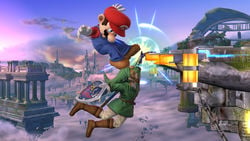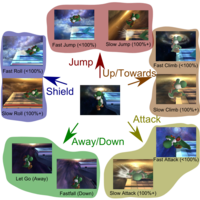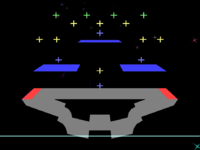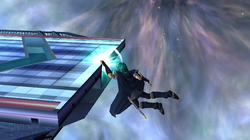Edge: Difference between revisions
KirbyMelee (talk | contribs) No edit summary |
mNo edit summary |
||
| Line 23: | Line 23: | ||
===Fast versus slow edge actions=== | ===Fast versus slow edge actions=== | ||
When a character's [[damage]] is lower than 100%, the character is considered "fresh", and is able to climb back onto the stage from the edge rather quickly. However, at percentages of 100% and above, the character can be considered "tired", and climbing becomes a harder task. As a result, all edge actions aside from letting go have two possible animations: one with the character performing the action in a fluent and fast manner, and another with the character in a messy and slow manner. The fast and slow animations are often | When a character's [[damage]] is lower than 100%, the character is considered "fresh", and is able to climb back onto the stage from the edge rather quickly. However, at percentages of 100% and above, the character can be considered "tired", and climbing becomes a harder task. As a result, all edge actions aside from letting go have two possible animations: one with the character performing the action in a fluent and fast manner, and another with the character in a messy and slow manner. The fast and slow animations are often noticeably different in execution, such as a quick flip kick versus a slow trip kick, or a quick roll versus a slow crawl. | ||
The slow actions were removed in ''Smash 4''. | The slow actions were removed in ''Smash 4''. | ||
Revision as of 05:52, June 15, 2016
- Not to be confused with the smasher Edge.

An edge (also known as a ledge, coded internally as cliff) is any part of a stage from which one can grab or tether (not to be confused with a wall grapple). Edges are often found at the ends of a stage's main platform. The edge therefore becomes an important element in the battle between an edge-guarder and a recovering opponent. Some stages can have many edges or none at all; on most tournament legal stages there is an edge on both ends of the stage (e.g. Final Destination).
The majority of edges on hard and semisoft platforms can be grabbed. Some edges cannot be grabbed, and so make recovery from that side of the stage significantly more difficult. Examples of ungrabbable edges include the moving platform of Peach's Castle (In Smash 64 only), the lower sides of Summit, and all Stage Builder blocks aside from the standard one (and even then, only if the edge is at least two blocks above a floor). Generally, soft platforms do not have grabbable edges, the main exception being those on Norfair.
In the original Super Smash Bros. and in Melee, a character cannot grab the edge if facing the opposite direction, with some exceptions, such as when using Falcon Dive and Spinning Kong in Melee. In Brawl and Smash 4, characters can grab an edge behind them, but with a range of 40% less than in front. Characters will automatically grab a nearby edge while in the air unless the player is actively holding down on the control stick or D-pad. Multiple characters cannot hold onto an edge at the same time, with the exception of the Ice Climbers in Brawl where both climbers belonging to one player can grab the same edge. When a character grabs an edge, they will briefly become intangible. This is the basis of ledgestalling (see that article for more detailed analysis of how edge-grabbing works in Melee).
The physics of grabbing edges have undergone a massive overhaul in Super Smash Bros. 4. In this game, air time and damage of a character affect how much intangibility is earned by grabbing the edge; a lower amount of each will prolong it. Damage no longer affects a character's recovery animations, so they always use their fast ones. Finally and arguably most importantly, attempting to grab an edge that someone else is already grabbing will gently remove them from the edge and then grab it, negating edge-hogging, and grabbing an edge a second time without touching the ground or being hit will not grant intangibility, negating planking.
Climbing

When hanging onto an edge, the player has five possible actions:
- Climbing
- Attacking
- Rolling
- Jumping (except in Smash 64)
- Dropping
Fast versus slow edge actions
When a character's damage is lower than 100%, the character is considered "fresh", and is able to climb back onto the stage from the edge rather quickly. However, at percentages of 100% and above, the character can be considered "tired", and climbing becomes a harder task. As a result, all edge actions aside from letting go have two possible animations: one with the character performing the action in a fluent and fast manner, and another with the character in a messy and slow manner. The fast and slow animations are often noticeably different in execution, such as a quick flip kick versus a slow trip kick, or a quick roll versus a slow crawl.
The slow actions were removed in Smash 4. Template:-
Hang time
Regardless of the character's physical strength, fighters can hold on to an edge for a determined amount of time. This amount can only be increased or decreased with Lingering Edge and Hasty Edge equipment respectively. For instance, grabbing a edge repeatedly within a short interval would logically decrease the amount of time. This, however, is not true in the games. The duration is also not affected by Metal Boxes, the character's size (mega or tiny), or any items he or she is carrying.
However, after the character's damage reaches 100%, the amount of time allowed is noticeably reduced. The following is a short list with the hang duration for each game.
| SSB | SSBM | SSBB | SSB4 | |
|---|---|---|---|---|
| Under 100% | 18 seconds | 11 seconds | 6 seconds | 7 seconds |
| 100% or more | 8 seconds | 8 seconds | 5 seconds | 6 seconds |
In Brawl, Pikachu notably is required to hang onto the ledge a few less frames than every other character.

